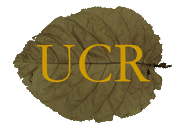Current floristic projects at UCR include the Flora of the San Bernardino Mountains (California), a Checklist of western Riverside County, and a floristic Inventory of the Curú Biological Reserve on the Nicoya Peninsula (Costa Rica). The San Bernardino Mountains flora is nearing completion, but quite a number of records still need to be checked for specific data points that are not in the current manuscript. This missing data includes such things as collection numbers and elevations. The computerization of the UCR inventory is being quite helpful for all these projects.
These projects are all part of the general effort to describe, explore and document the biodiversity of the world vegetation. The flora of the planet is still very poorly known, even in "well studied" areas such as California, as is illustrated by the discovery of new plant species in California at the rate of 10 or so a year. Furthermore, there is also a continuous rain of propagules of alien plant species. Some of these become established and spread widely in the natural environment of southern California, displacing native plants as they expand. Native species may also change their ranges over time, due to other environmental alterations, such as climate change. Herbarium specimens often provide the only record of these changes.
Examples of the result of this on-going efforts include:
- » Specimens of Calystegia felix were collected in the late 19th century and up to 1917. However, the limited material (3 specimens) was poor. One consequence was the species was not recognized as distince. It was confused with another (not closely related) rare species that was equally poorly known. It was finally scientifically described in December 2013 by UCR Herbarium staff.
- » The native annual grass Bromus trinii (B. berteroanus) was apparently widespread in the dry interior of southern California in earlier times, but, following the introduction of weedy European brome grasses (B. diandrus, B. rubens, etc.) in the 19th century, its coastal slope populations largely collapsed. The species persisted on the Mojave Desert where weed competition was less intense. Among the last populations on the coastal slope were those represented by the UCR collections made by F.M. Reed in around 1907. However, very recently, we have found a few remnant populations of B. trinii on particularly arid slopes in western Riverside County, showing the it is still hanging on despite not having been seen in western Riverside County in over 100 years prior to 2010.
- » Oncosiphon piluliferum was first found in North America by a UCR student in 1981. It has now spread throughout coastal southern California and even into Arizona. Populations are now locally huge, often consisting of thousands of plants at a given location.
- » Hemizonia (Deinandra) mohavensis had not been seen since 1933 and was thought to be extinct. It was rediscovered in 1944 by UCR Herbarium staff.

